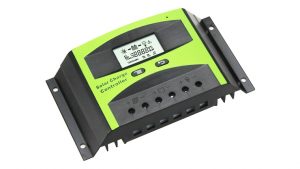
Charge control devices controls the energy coming from solar panels. It adjusts the current and the voltage then send it to batteries. Charge control device prevents over charge and over discharge of the batteries. Therefore, it protects the system. Each solar energy systems requires a charge control device. Charge control devices divided into two as PWM (Pulse Width Modulation) and MPPT (Maximum Power Point Tracking)
PWM stands for Pulse Width Modulation. PWM charge control devices can be explained as an electrical switch between batteries. The switch can be quickly switch on and switch off. Therefore, desired voltage can be obtained to charge the batteries. The charge current will be slowly decreased as the batteries charged.
MPPT stands for Maximum Power Point Tracking. MPPT is a technique to observe and regulates the energy going from solar panel to the batteries. Solar panels show changeable outputs according to weather conditions. MPPT charge control devices can match the solar panel voltage with battery voltage to maximize the charge efficiency. In these systems, the full power of solar panels can be used by balancing between voltage and current according to the P = V x A equation. For example, the amount of current drawn from the panels reduced to protect the voltage when the weather is cloudy. When the weather is sunny, it is allowed to draw more current.
The main difference between PWM and MPPT charge control devices is that the MPPT devices are more efficient. MPPT charge control devices have 30 % more efficient in charge efficiency according to PWM type. Panel voltage and battery voltage should be matched in PWM systems. In MPPT systems, the panel series are allowed to have higher voltage than batteries. This means more flexibility for system growth.
On the other hand, MPPT controllers are more expensive than PWM controllers. Because of that, in small systems where the efficiency is not critical, PWM Controllers are used.
The size of the solar energy system is important to choose charge control device. MPPT charge control devices are the best for professional applications. PWM charge regulators can provide sufficient performance in small applications which does not need more property. The efficiency difference between PWM and MPPT may not be sufficient to justify the price difference in small projects. However, in big projects, it plays a huge role about how well the system performance.

